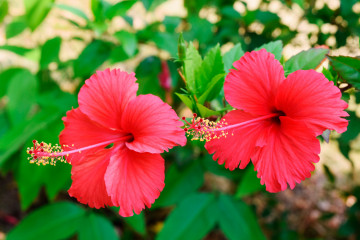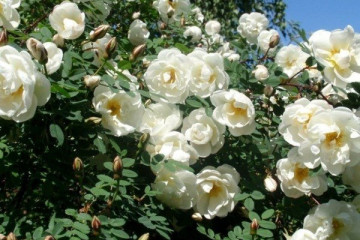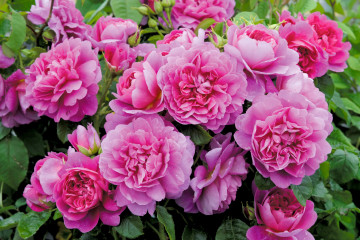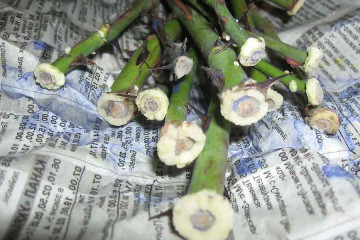Park rose - what is it, what it looks like
Content:
Park roses are amazing flowers that attract attention with their unusual beauty. The plant initially gained its popularity in England, then around the world. Currently, English roses adorn homesteads, city squares and parks. A distinctive feature is excellent winter hardiness, so the plant is grown even in remote corners with harsh winters.
What is a park rose
When growing park roses, you need to have an idea of the plant, to know all the strengths and weaknesses.
The plant is divided into 3 types:
- cultivated rose hips;
- old rose;
- modern hybrids.
The park rose blooms in early summer. The color of the flower is multifaceted: snow-white, cream, peach, red and even lilac. The buds are rough to the touch, double, the number of petals exceeds 100 pieces. More than one varietal plant cannot boast of these qualities.
Description and characteristics of the plant
A park rose is a tall, unpretentious shrub with a height of 1.5 to 3 meters. The spreading plant tolerates severe cold well, blooms profusely and for a long time. The color and structure of the flower depends on the variety. A park rose, like any plant, has pros and cons.
The advantages include:
- long flowering;
- cold resistance;
- a large assortment of varieties;
- resistance to disease.
Disadvantages of the view:
- some varieties need shelter for the winter;
- the plant is demanding for watering;
- every 4-5 years, it is necessary to divide the bush.
Characteristics of species and varieties of crops, how they look
Currently, there are a large number of varieties. They differ from each other in size, flower color, flowering duration.
Floribunda
Today, the floribunda rose is one of the most popular varieties. Plants are frost-resistant, unpretentious, resistant to diseases and pests, blooms from the beginning of summer until the first cold weather.
Remy Martin
The park rose Remy Martin was bred in France in 1995. A perennial plant is a tall shrub with branched, thornless shoots and dense, dark green foliage.
In early summer, the bush is covered with pointed buds with tight-fitting petals. Dissolving, they transform into double flowers with a diameter of 6-8 cm. The color of the inflorescences is copper-golden with an apricot tint. During the wilting period, the outermost flower petals turn pink.
Inflorescences can be single or collected in clusters of 3-5 pcs. Flowering is long and lasting. During the opening of the buds, a soft, pleasant, unobtrusive aroma appears in the air.
Fluorescent
The variety has a powerful, spreading bush of the correct shape. The plant blooms 2 times a season.
The first wave occurs in June, the plant blooms again in mid-July. During flowering, cup-shaped buds appear among the dark green, glossy foliage, which bloom to form double flowers of bright red color.
Inflorescences are collected in a brush of 3-5 pcs., Thanks to this, the flowering bush looks gorgeous and festive.
Rose hips
Rosehip or dog rose is a common plant that can be found within the city and in personal plots.
Thanks to the wide variety of varieties, a beautiful blooming combination can be created. Caring for rose hips is not difficult, so it will suit even an inexperienced gardener.
Louise Bugnet
Canadian species of park rose hips. The plant forms a compact shrub of one meter height. Flowering occurs in 2 steps: the first wave begins in June, the second at the end of July. The variety has a peculiarity - at the beginning, bright cherry buds appear, when blooming, snow-white petals appear with a slight pistachio or purple tint.
Like all hybrids, the plant does not hold open flowers for a long time. After blooming, the flower lives for 2 days, then the petals fly around. It is replaced by new inflorescences, so the bush looks luxurious throughout the warm period. The aroma of the flower is not strong, but persistent.
Marchenland
The shrub is 1.5 meters high and has straight shoots with large, often spaced thorns.
Among the large dark green foliage with a glossy surface, large semi-double flowers of a light pink shade with a delicate orange tint appear at the beginning of summer. Long-lasting and abundant flowering.
Musk hybrids
This species forms a powerful bush up to 4 meters high. In early summer, the plant is covered with large double flowers, 8 cm in diameter. The color of the inflorescences depends on the variety. For abundant flowering, it is important to plant the rose in an open, sunny place.
Elmshorn
The variety was bred in Germany in 1951. A tall, strongly vigorous bush reaches 2 meters in height.
At the beginning of flowering, the inflorescences are painted in a pale crimson color, as they bloom, the petals turn dark pink. In hot weather, double flowers can fade.
Inflorescences are collected in a brush of 10-20 pieces. During flowering, the air is filled with a light nutmeg aroma with apple notes.
Likhterlo
An upright bush, up to 80 cm high, densely covered with dark green leathery leaves. Flowering is profuse and long lasting. At the beginning of summer, the plant is covered with blood-red double flowers, 8 cm in size.
The variety is winter-hardy and unpretentious. For abundant flowering, the seedling is planted in an open, sunny place, protected from northern winds. The rose is planted singly, in rose gardens and composite plantings. Flowers are cut for a long time.
Shrubs
This shrub group appeared 50 years ago. There are varieties of tall, low and climbing. Branched varieties require support. They are hardy and rarely suffer from disease. Flowering is lush and abundant, prolonged or repeated. Flowers exude a pleasant aroma.
Moden Fireglow
The Canadian rose forms a dense erect bush 100 cm high. The variety has a high winter hardiness and beautiful color of flowers. Intense orange-red semi-double flowers are collected in clusters of 3-5 pieces.
The first flowering is plentiful; at the end of summer, single specimens appear on the bush. In autumn, after flowering, rounded polyspermous fruits are formed.
Ghislaine de Feligonde
This variety is often used for hedging and vertical landscaping. The re-flowering shrub reaches up to 2 meters in height.
In early summer, the plant is covered with small peach-pink flowers, which, as they bloom, change color to a lighter color. In sunny weather, the petals fade and become white; in cold weather, the flower has a pale pink color.
All flowers do not change their color evenly, which makes the plant multi-colored.
Explorer Series
This group belongs to the high quality Canadian rose. The varieties are resistant to low temperatures, bloom for a long time and profusely. The color of the flower is from light pink to dark red. The disadvantage of the group is poor resistance to prolonged rains.
Cuthbert Grant
An outstanding variety with cupped, semi-double, dark purple flowers. When fully expanded, bright yellow stamens can be seen in the center. 3-9 flowers are collected in clusters and are located on strong, resilient shoots. The bushes are erect, reaching a height of 120 cm. Large ash-green foliage is in perfect harmony with bright flowers with a persistent strong aroma.
The variety is frost-resistant, hardy and unpretentious. Not afraid of temperature changes, blooms throughout the warm period. It is well cuttings, the bush is not covered for the winter.
Bush roses
The bush group reaches a height of 3 meters and forms large flowers of various colors. The varieties included in the group are not whimsical and belong to non-covering roses.
Eifelsauber
A young variety bred in Germany in 2008. A strong shrub grows 70 cm in breadth and 120 cm in height.
In early summer, pointed orange-red buds break through from the dark green foliage. As they bloom, the petals take on a light pink color with a delicate aroma.
Long-term and repeated flowering. The first wave occurs in June, the second time the bush blooms in mid-July. Densely double flowers are large, with a strong aroma. The winter-hardy rose variety is unpretentious, therefore it is suitable for novice florists.
Also, experienced gardeners recommend other unpretentious varieties. Name of popular park roses:
- Westerland - suitable for landscaping vertical buildings;
- John Davis is a sophisticated aristocratic variety;
- Lady of Shallot is one of the most frost-resistant and unpretentious varieties;
- Abraham Derby - the variety was bred by the famous breeder David Austin;
- Agrant is a re-flowering variety with a strong aroma.
Classification of park roses
The park rose is subdivided into single blooming and re-blooming. These species differ in the rules of care, flower color and shelter for the winter.
Single flowering
One-time flowering varieties are not recommended to be cut off, since flowers appear on last year's shoots. The rose does not require bending the shoots and shelter for the winter. This group is called cultivated rose hips. Due to their unpretentiousness, such roses are often grown on personal plots in regions with a harsh climate.
The most popular varieties:
- Wasagaming;
- MinnEt;
- Poppius the scrub.
With repeated
Re-blooming roses are divided into 3 subgroups;
- frost-resistant varieties of roses;
- Canadian park roses;
- a group that does not hibernate without shelter.
Hybrids are frost-resistant, but the species cannot boast of a variety of shapes and color of the flower. Some rugoses need shelter from the cold.
Canadian roses are very popular. Florists distinguish the following varieties: Morden Centeniel and Prairie Joy.
Covering varieties include a wide variety of shapes and colors.This group includes old re-flowering and Burgon varieties, as well as Fisherman Friend, Meijana, Cordesa, Tantus.
Non-sheltered park roses
Many beautiful varieties are hardy and do not require shelter for the winter. There are 3 types of roses that endure the winter cold:
- Medium-hardy - they can freeze out in places where there is no snow cover.
- Winter-hardy - tolerate frosts well in an upright position, but in severe frosts they can freeze a little.
- Absolutely cold-resistant - this means that the varieties are not afraid of the most severe frosts.
For wintering without shelter, it is important to follow simple rules:
- landing is made in a place protected from the winds;
- the soil must be well drained;
- groundwater should not be located on the surface;
- for successful wintering, the shrub needs careful care;
- roses are best grown in a well-lit area.
The main diseases and pests of culture
Most park rose varieties are immune to diseases and pests. But if agricultural technology is not followed, they can settle on the bushes:
- Powdery mildew - a white bloom appears on the foliage, which can be easily removed with a finger. Without treatment, the plant dies. You can help the plant by spraying with copper-containing preparations.
- Rust - in spring, small tubercles with fungal spores appear on the shoots and foliage. To stop the development of the disease, the bush is treated with Bordeaux liquid, a decoction of nettle or wormwood.
- Black spot - the leaf blade is covered with dark brown spots with yellow edging. If a disease is detected, the affected areas are removed, and the bush is sprayed with foundation or coniferous broth.
Aphids often appear from insect pests on a park rose, which, by sucking out the juice, significantly weakens the plant. You can get rid of it with insecticides or folk remedies.
Park bush rose is a beautiful, unpretentious plant. By choosing the variety you like best and observing the rules of care, you can grow a gorgeous bush that will bloom profusely and for a long time, exuding a pleasant aroma. Thanks to the luxurious, spreading bushes, you can not only transform your personal plot, but also mark its boundaries.





























